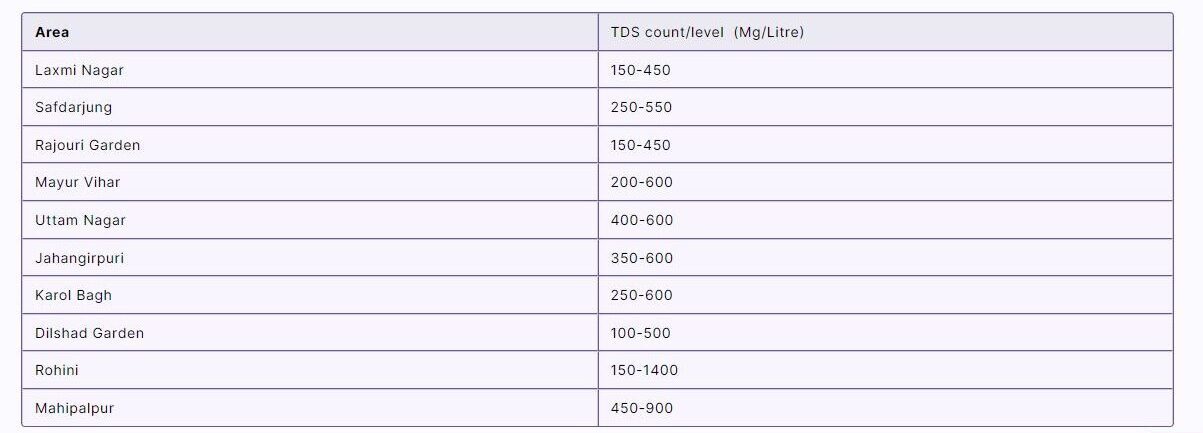Access to clean and safe drinking water is a priority, especially in cities like Delhi where water quality can vary significantly from one area to another. Total Dissolved Solids (TDS) levels, an important indicator of water purity, differ across various neighborhoods, as seen in areas like Laxmi Nagar and Rohini where levels can range from 150 to 1400 mg/L. To ensure the water you consume is safe, it’s essential to monitor TDS levels and use an RO water purifier, supported by reliable services like RO Service Center for optimal performance.
What is TDS in Drinking Water?
TDS, or Total Dissolved Solids, represents the concentration of dissolved substances in water, including minerals, salts, and metals. While some of these dissolved solids are essential for health, excessively high levels can indicate the presence of harmful contaminants like lead, arsenic, and nitrates, which can negatively impact your health. TDS is measured in parts per million (ppm), and understanding its levels in your water is critical for maintaining water safety.
TDS Levels in Different Areas of Delhi
The TDS levels in drinking water can vary widely across different regions of Delhi, depending on the water source and local environmental factors. Below is a table that shows TDS levels in various Delhi neighborhoods:

As the table shows, certain areas like Rohini and Mahipalpur have significantly higher TDS levels, reaching up to 1400 mg/L, whereas regions like Laxmi Nagar and Rajouri Garden exhibit much lower levels, ranging from 150 to 450 mg/L. It’s important to note that the ideal TDS level for safe drinking water typically falls between 50 and 150 ppm, making it clear that many areas in Delhi exceed these recommended levels, necessitating proper water treatment.
Ideal TDS Level for Safe Drinking Water
While TDS itself does not specify what substances are dissolved in the water, a higher TDS level could signal the presence of potentially harmful contaminants. According to water safety standards, a TDS level below 500 ppm is generally considered safe for drinking. However, the ideal TDS range for drinking water falls between 50 to 150 ppm. Here’s a breakdown of TDS ranges and their implications:
Less than 50 ppm: Water is too pure and lacks essential minerals, which can make it taste flat and not ideal for long-term consumption.
50 to 150 ppm: Ideal range for drinking water, as it offers a good balance of purity and essential minerals.
150 to 300 ppm: Still acceptable for drinking, though it may have a slightly altered taste due to the presence of more dissolved solids.
300 to 500 ppm: Safe for drinking but may have a distinct taste, which may not be preferred by some.
Above 500 ppm: Not recommended for drinking without purification, as it may contain harmful contaminants.
How RO Water Purifiers Help Manage TDS
In areas where TDS levels exceed the recommended range, an RO (Reverse Osmosis) water purifier is essential. RO purifiers use a semi-permeable membrane to filter out impurities and dissolved solids, significantly reducing TDS levels to provide safe, clean drinking water. RO systems are particularly effective in regions with high TDS levels, such as Rohini and Mahipalpur, ensuring that water is free from contaminants while retaining essential minerals.
However, using an RO water purifier without proper maintenance can affect its performance. This is where services like the RO Service Center come into play. Regular maintenance and timely filter replacements ensure that your RO purifier continues to function efficiently, providing you with safe drinking water year-round.
Why TDS Levels Matter for Health
Consuming water with excessively high TDS levels can expose you to harmful contaminants, which can lead to health issues over time. High TDS water may contain salts, heavy metals, and other impurities that not only affect the taste but can also be detrimental to your kidneys, bones, and other vital organs. Conversely, water with too low TDS might lack essential minerals like calcium and magnesium, which are important for overall health.
In regions with particularly high TDS levels, using an RO water purifier becomes a necessity. By filtering out harmful substances and balancing TDS levels, an RO system ensures that you and your family have access to safe, healthy drinking water.
Conclusion
The table illustrates the varying TDS levels across different areas of Delhi, with regions like Dilshad Garden and Laxmi Nagar showing moderate levels, while areas such as Rohini and Mahipalpur face higher concentrations. To ensure safe drinking water, particularly in areas with elevated TDS, installing an RO water purifier is crucial. For residents seeking reliable maintenance and upkeep, RO Service Center provides expert services to help maintain optimal water quality, ensuring your purifier functions efficiently to deliver safe, clean water.
Don’t Miss: Preventing RO Membrane Fouling and Extending Its Lifespan




